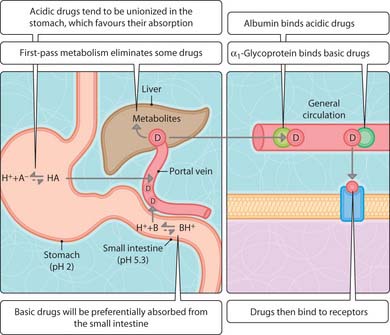3 Pharmacokinetics
absorption and distribution
Absorption
Drugs can be administered by a number of routes:
 oral: convenient but drugs are subject to first pass metabolism in the liver and it is not suitable for agents readily destroyed by bacterial enzymes or the acid environment of the stomach (e.g. insulin) unless the drug is protected in some way (e.g. a coated tablet). Drug absorption by this route is altered by gastric motility, pH at the site of absorption, mucosal blood flow and the presence of food
oral: convenient but drugs are subject to first pass metabolism in the liver and it is not suitable for agents readily destroyed by bacterial enzymes or the acid environment of the stomach (e.g. insulin) unless the drug is protected in some way (e.g. a coated tablet). Drug absorption by this route is altered by gastric motility, pH at the site of absorption, mucosal blood flow and the presence of food inhalation: suitable for general anaesthetics and when the lung is a target for therapy (e.g. salbutamol in asthma); it minimizes systemic levels of drug because a lower total dose can be given and any swallowed portion will be subject to first pass metabolism
inhalation: suitable for general anaesthetics and when the lung is a target for therapy (e.g. salbutamol in asthma); it minimizes systemic levels of drug because a lower total dose can be given and any swallowed portion will be subject to first pass metabolism subcutaneous (s.c.) or intramuscular (i.m.) (injection): useful for drugs in aqueous form; drugs can be formulated to slow the rate of absorption (e.g. contraceptive implants)
subcutaneous (s.c.) or intramuscular (i.m.) (injection): useful for drugs in aqueous form; drugs can be formulated to slow the rate of absorption (e.g. contraceptive implants) parenteral (intravenous (i.v.) injection): advantageous for rapid pharmacological effect and when continuous infusion is required
parenteral (intravenous (i.v.) injection): advantageous for rapid pharmacological effect and when continuous infusion is required rectal (suppository): avoids first pass metabolism because there is limited portal blood flow from the lower gastrointestinal tract.
rectal (suppository): avoids first pass metabolism because there is limited portal blood flow from the lower gastrointestinal tract.In order for a drug to be absorbed into the systemic circulation, it must be able to cross cell membranes. These membranes are mainly composed of lipids so lipophilic molecules will readily diffuse across these structures. Most drugs exist in an ionized (charged) and a non-ionized (uncharged) form in solution and it is the latter that readily penetrate cell membranes. The amount of drug absorbed across cell membranes will depend upon the amount of drug in the non-ionized form (Fig. 3.3.1). The extent to which a drug is non-ionized will be dependent upon the pH of the environment and the drug’s pKA (negative logarithm of KA). The pKA is equal to the pH at which 50% of a drug is ionized in solution (Fig. 3.3.1). Some charged molecules can be transported across cell membranes by specific carrier proteins residing in the cell membrane.
< div class='tao-gold-member'>
Stay updated, free articles. Join our Telegram channel

Full access? Get Clinical Tree







